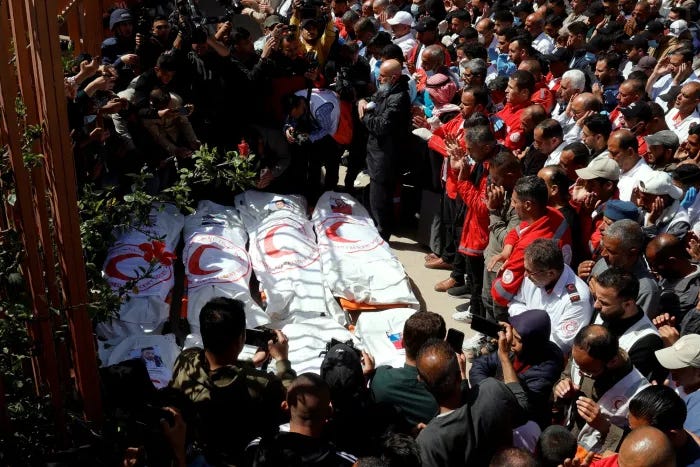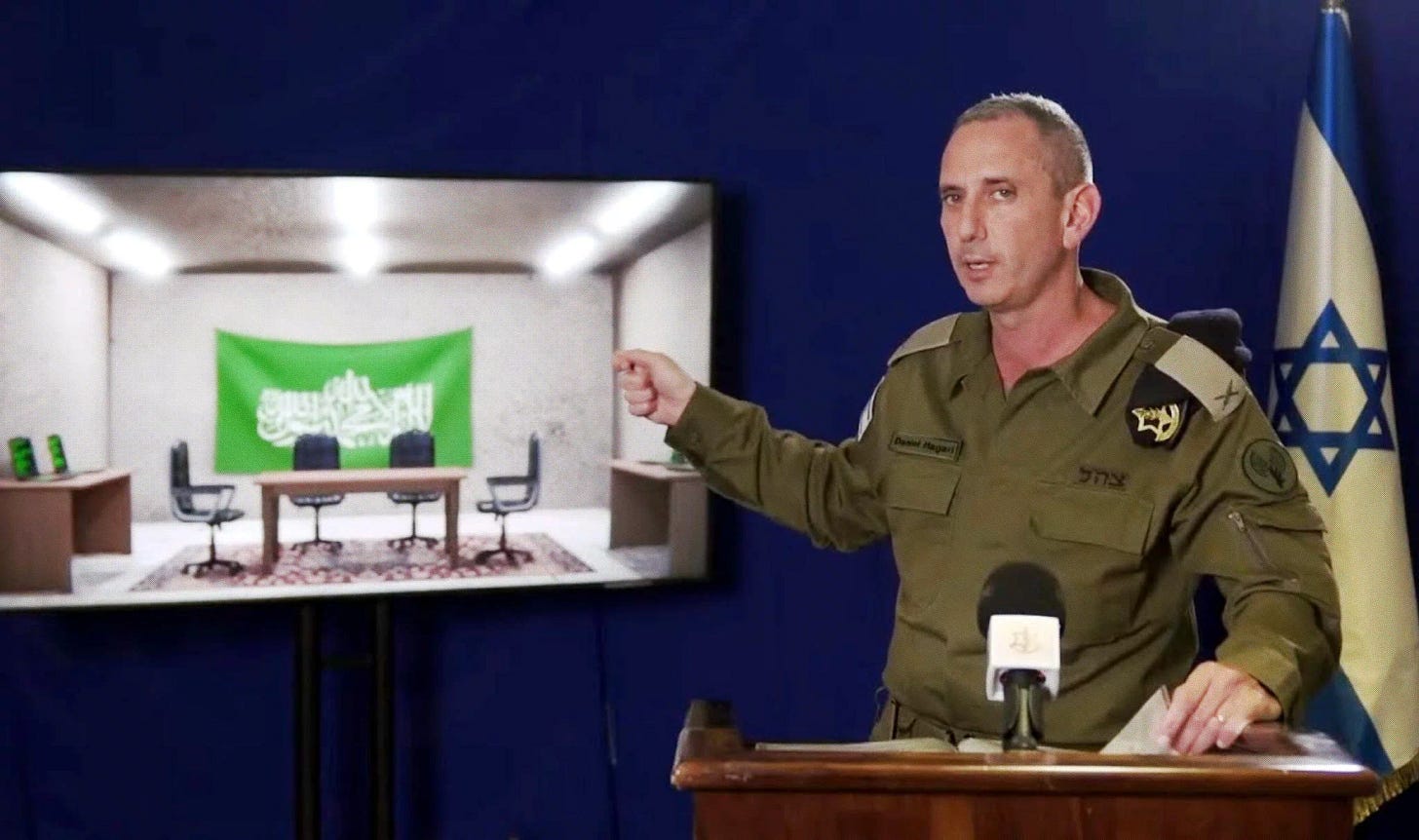“I personally examined this image, and what the public doesn’t see is that it’s not 20 meters underground, but just one meter deep. It’s a covered water passage beneath a street, covered with soil. Someone took a photo, stirred up a fuss, and created a media frenzy. But in the end, no weapons passed under the Philadelphia Corridor.”
With these words, former Israeli Defense Minister Yoav Gallant exposed a new scandal regarding a supposedly massive tunnel beneath the Philadelphia Corridor in Rafah, southern Gaza on the border with Egypt. But this uncovered falsehood was far from the only one pushed by the Israeli army during its war on Gaza.
Over more than a year and a half, Israel’s record has been riddled with lies and disinformation campaigns—meant to save face, justify military action, and delegitimize Palestinian resistance—only to be exposed through international reports, Israeli and global media, or internal contradictions.
The Tunnel Lie: A Manufactured Image
The campaign began with the deliberate release of a photo by the Israeli military on August 14, claiming to show a massive, multi-story Palestinian resistance tunnel in Rafah. Described as a major discovery, it was said to be tens of meters deep and three floors high.
But Yoav Gallant, who resigned from the Knesset in January after being dismissed from the Defense Ministry, debunked the claim on Israeli broadcaster Kan. He admitted that what was found was a shallow trench just one meter deep—nothing more than a stormwater drain.

His confession revealed a broader strategy: fabricating stories about tunnels to suggest weapons were being smuggled from Egypt, thereby justifying continued Israeli control over the Philadelphia Corridor and stalling a prisoner exchange deal with Hamas.
The Paramedics Massacre: An Anatomy of Deceit
Gallant’s revelation was just one in a string of exposed lies. Another came with the killing of 15 Palestinian civil defense and Red Crescent paramedics on March 23 in Rafah’s Tel al-Sultan neighborhood, known now as the “Paramedics Massacre.”
The Israeli narrative claimed the convoy included Hamas members and that ambulances lacked lights, sirens, or protected uniforms—allegedly giving soldiers grounds to open fire.
But video evidence published by The New York Times, recorded by a medic before his death, disproved these claims. The Israeli army was forced to retract its account and reopen an investigation, blaming “false testimonies” by soldiers.
Even the internal investigation was riddled with half-truths: the army admitted “professional failures,” denied executing medical crews, and dismissed evidence of handcuffed victims with gunshot wounds to the head and chest.

Israeli media told a different story. Haaretz reported that Israeli forces fired on the ambulances at point-blank range for over three minutes, repeatedly reloading, even as paramedics attempted to identify themselves.
Some bodies were found in a mass grave. The army’s internal probe appeared more about managing PR than uncovering the truth.
This mirrored earlier incidents: in February 2024, Israel blamed stampedes for the “Flour Massacre” on al-Rashid Street, only to later admit to shooting into the crowd. In April, it assassinated seven World Central Kitchen aid workers, then chalked it up to an “operational mistake.”
The Human Shield Myth
In October 2023, the Israeli army circulated a video claiming Hamas leader Yahya Sinwar hid in a tunnel with his family ahead of Operation Al-Aqsa Flood, abandoning civilians and using them as human shields.
The truth, however, was far different. Sinwar ultimately fought above ground, leading resistance operations until his death.
While Israel brands its military as “the most moral army in the world,” evidence shows it has used Palestinian civilians as human shields: forcing detainees to wear IDF uniforms, clear rubble with bare hands, and enter suspect buildings.
The Israeli military eventually admitted to violating humanitarian law and pledged an investigation—claims that echo its documented use of human shields during the Second Intifada.
False Assassinations
On December 3, 2023, Israel claimed to have killed Haitham al-Hawajri, commander of the al-Shati Battalion, sharing his photo and declaring his battalion destroyed. But in February 2024, Hawajri appeared alive, escorting an Israeli hostage handover to the Red Cross and later attending a funeral for fallen resistance fighters.
Similarly, in May 2024, Israel said it had killed Hussein Fayyad, commander of the Beit Hanoun Battalion, during a tunnel strike in Jabalia. But in January, he was seen alive at the site where Israeli soldiers were killed. Again, the military blamed “faulty intelligence.”
Fabricated Narratives in Gaza Hospitals
On Day 20 of the war, IDF spokesperson Daniel Hagari stood in front of a map, claiming Hamas operated from underneath al-Shifa Hospital. Fifteen days later, Israeli forces stormed the hospital, evacuated it, and called it a triumph.
But critics say the operation was about stopping doctors from counting casualties and forcing Gazans to flee.
A now-deleted video from army spokesman Jonathan Conricus showed weapons “discovered” in an MRI room, along with a laptop allegedly showing an Israeli hostage. The video was edited and reuploaded within an hour, with key elements removed.
CNN and BBC journalists later entered al-Shifa under Israeli escort and found no conclusive evidence. CNN noted inconsistencies in weapon placement. BBC said they weren’t allowed to interview anyone.
Israeli analyst Yossi Melman dismissed the claims: “No command center, no hostages, no Hamas leadership.”
The IDF later claimed it had discovered a tunnel—again debunked by a Palestinian engineer who showed it was an ordinary conduit for power cables.
Similar falsehoods were pushed about al-Rantisi Hospital and the al-Ahli Arab Hospital massacre. In the latter case, Israel claimed a misfired Islamic Jihad rocket caused the carnage. President Biden repeated the claim—despite mounting evidence to the contrary.
Visual forensics revealed a blast consistent with Israeli airstrikes. Activists cited The Wall Street Journal, reporting that an MK-84 bomb—recently supplied by the U.S.—was likely used.
Videos cited by Israeli accounts as proof turned out to be years old. One tweet by Netanyahu’s digital spokesperson openly admitted Israel had struck the hospital—only to be deleted and replaced with a denial.
The World Health Organization confirmed that al-Ahli was among 20 hospitals ordered to evacuate. A hospital doctor said plainly: “Israel threatened to bomb hospitals—and then did.”
Lies the West Wants to Believe
In the fog of war, Israel pushed some of its most extreme falsehoods. Claims that Hamas beheaded 40 babies and raped women spread across Western media, adopted by leaders including President Biden.
But no evidence ever emerged. The “beheading” claim was traced to a single settler. Journalists and military officials eventually admitted the stories couldn’t be verified.
CNN’s Sara Sidner, who reported the beheading allegation, later apologized: “I wasn’t accurate. I didn’t verify properly.” Even Biden’s administration walked back his statements, saying he had merely “heard” them from Israelis.
The IDF itself later admitted it had found no evidence of rape during the October 7 attacks.
A Culture of Deception
It’s no surprise that an army committing mass atrocities would also lie. But as journalist Jonathan Cook points out, the difference with Israel is that deceit isn’t a tactic—it’s foundational to a colonial regime that began with the myth of “a land without a people.”
That myth enabled mass expulsions and continues to sustain an apartheid reality.
Today, media complicity allows Israeli lies to flourish—even as they are repeatedly disproven. The goal isn’t truth; it’s to win the narrative war, especially after failing to achieve victory on the ground.
But Israel’s disinformation machine increasingly looks amateurish—just like its intelligence failures before October 7.



